Coverage of the 2020 Presidential Elections in Belarusian Media. Report 2
The Belarusian Association of Journalists presented the second interim results of monitoring the media coverage of the 2020 presidential election.
The Belarusian Association of Journalists
Monitoring: The 2020 Presidential Election Coverage in the Belarusian Media
Report 2 (5 July – 2 August, 2020)
1. Introduction
The report sums up the findings of the second stage of the monitoring. During this time span five of the presidential nominees were registered as candidates and began campaigning. They were granted an opportunity to address voters on TV and the radio, as well as publish their programmes in the press.
2. Summary
Just like at the first stage, the state-run media continued to present the incumbent, who has also been running for presidency since 14 July, in a highly positive light.
Before the registration, some state-run media increased the share of items that gave negative assessments of Viktar Babaryka, at the time the most popular opponent of the current regime. The same media went on portraying him in a negative light even after he was denied registration.
The registered candidates were granted access to the state-run media. However, the incumbent, who is seeking re-election, refused to record media addresses to voters or take part in debates.
The candidates’ media appearances were broadcast at off-peak slots. Their supporters and opponents couldn’t discuss the contents on the state-run TV and radio stations.
The candidates’ media appearances were not promoted and the TV and radio guides did not give their names. There was no information about the order and exact time when each of the candidates was to go on air. The TV and radio guides just mentioned ‘Media appearances of presidential candidates’.
The presidential campaign began to draw a lot of attention. However, apart from the direct access, the registered presidential contenders received a meagre amount of airtime and space in the state-run media.
The overall information background for the presidential campaign coverage was about the country’s successes in economy, social welfare, medicine, and culture. According to the state-run media, all the achievements became possible only thanks to the talent of the incumbent president and the Belarusian nation.
At the same time, the state-run media claimed that foreign destabilising forces had managed to put the country’s sovereignty and integrity under threat and Belarus could lose its independence and disintegrate if their agents rose to power.
Any alternative viewpoints were conspicuous by their absence from the state-run media. Their journalists and guest experts aired and propagated just one stance, supported by the government. Moreover, they enjoyed an exclusive right to interpret the positions and opinions of their opponents, who were never given an opportunity to air their views in person.
The independent media focused on the key actors of the presidential race, as well as its progress and dynamics. They certainly put the spotlight on the candidates and their political agendas. Rallies held by the candidates, public initiatives for election observation and vote count, and detentions of peaceful protesters and independents journalists featured prominently in these media.
3. Nominees, candidates and specific features of the election coverage
3.1 State-run media
The state-run media went on smearing the most popular contender Mr Babaryka even after he was denied registration. For example, on 15 July, 2020 Panarama on Belarus 1 TV station spoke of an illegal international money laundering network, which included Belgazprombank with its former CEO at its head. The Glavny Efir weekly programme on 19 July, 2020 also demonstrated a clear prosecutorial bias in the way it presented Mr Babaryka.
It is a telltale sign that the TV stations used evidence provided by the investigation before any court hearings even took place, thereby grossly violating the presumption of innocence and investigation secrecy.
Just like before his registration as a presidential candidate, the incumbent’s visits to a wide range of places continued to be extensively covered by the state-run media. In the course of these visits President Lukašenka held a lot of meetings with local office holders, the military and local population.
The well-known columnist Mr Hihin explained the reason for such unusual meetings, ‘Few people have seen the paper produced by the Operational and Analytical Centre. The first part shows that the pandemic resulted in a decline in trust. In which regions? The paper names Minsk, as well as Brest and Hrodna regions. Where did Aliaksandr Lukašenka hold his most impressive meetings during this time span? In Minsk, as well as Brest and Hrodna regions.’ (Nichego Lichnogo [Nothing Personal], ONT, 16/07/2020)
Thus, the incumbent who is seeking re-election began campaigning at least before the mid of June by visiting Hrodna region. One of the reasons for the visit was a fall in his rating.
A telltale sign: the nominees’ registration as candidates had no influence on the distribution of airtime and space in the state-run media. The same one person, namely the incumbent, continued to dominate the most highly-rated shows on Belarusian TV and state-run papers.

This is supported by our quantitative data. After the formal registration, Panarama on Belarus 1 allocated 56% of its airtime given to all the monitored actors to Mr Lukašenka as presidential candidate. (The total presence of Mr Lukašenka as both a presidential candidate and the incumbent accounted for 82% of the coverage given to all the monitored actors.) Panarama mentioned all the other candidates just in passing.
The same pattern was also typical of Nashi Novosti news on ONT. Of the airtime given to all the monitored actors, Mr Lukašenka as a presidential candidate received 53% of coverage (the combined presence of Mr Lukašenka both as a candidate and the incumbent made up about the same percentage as on Panarama). Meanwhile, the most popular contender Mrs Cichanoŭskaja’s share was only 0.03%.
The SB. Belarus Segodnya and the Zviazda nationwide papers represented Mr Lukašenka as a candidate and the incumbent in a similar way, at the same time avoiding any mention of his contenders.
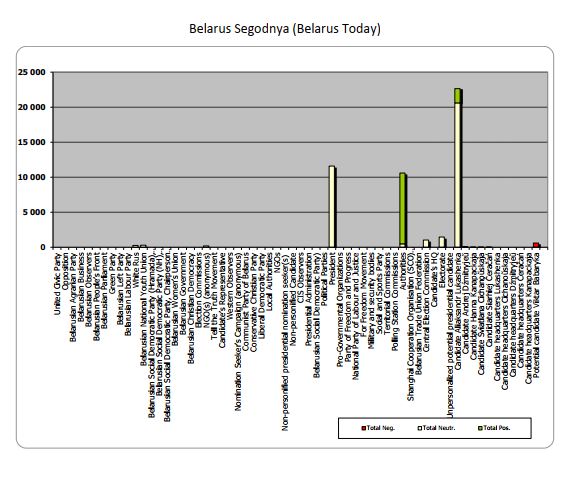
The electronic media broadcast a number of particular media items aimed at promoting the incumbent seeking re-election. These were special pieces and projects that demonstrated Belarus’ achievements under the rule of President Lukašenka for the last twenty-five years.
A ‘secret’ document about the incumbent/candidate Lukašenka’s rating can be viewed as another special media project. It was the TV political analyst and Lukašenka’s election agent Kryvašejeŭ who uploaded this document on his Facebook account.
The document claimed that the country leader’s rating was 76%. A few days later the media announced the findings of another opinion poll, conducted by little-known Ecoom analytical centre. On 19 July, 2020 the presenter of Glavny Efir on Belarus 1 said, referring to this survey, ‘The poll showed high trust in the incumbent President. It was a bit more than seventy eight per cent. It includes not only the electoral rating, but also the assessment of the social and economic policies implemented by the head of state, as well as the efficiency of his decisions.’
Finally, according to another opinion poll conducted by the same Ecoom analytical centre on 23–27 July, the proportion of voters who were ready to support the incumbent rose from 69% to 72%. Meanwhile, the combined rating of all the other candidates was below 10%.
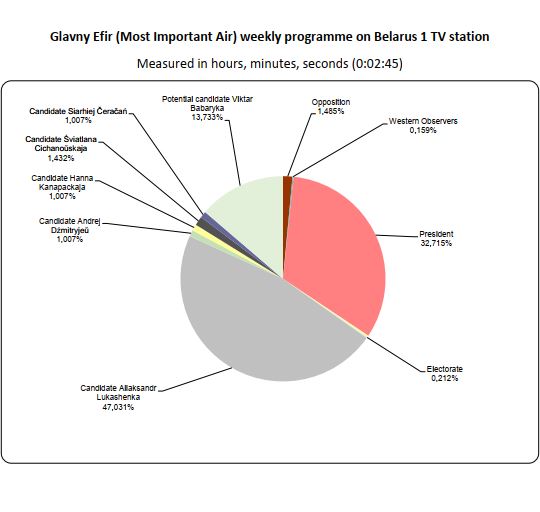
Another specific feature of the 2020 election coverage is numerous statements in the state-run media that this election might lead to a loss of state sovereignty and the country’s territorial disintegration. Until recently the state-run media highlighted a foreign conspiracy and ‘puppeteers’ from East and West, but during this monitored time span allusions to conspiracies were less pronounced. This time, it turned out that the key destructive forces were concentrated inside the country. On 16 July, 2020 Panarama on Belarus 1 quoted Andrej Raŭkoŭ, State Secretary of the Security Council of Belarus, as saying, ‘You must understand one clear thing. Most commonly war in these conflicts did not start spontaneously by an air attack, an impact of radio-electronic means of destruction or a ground invasion. As a rule, it began in the streets and in the square. And this square – take Tahrib [sic! – translator’s note], take Syria, take the radical actions in Ukraine. (…) And our task is to prevent ruining the state! To prevent bloodshed among the people!’
Some independent Belarusian and foreign media were also accused of conflict orchestration. Appearing on Klub Redaktorov (Edotors’ Club) TV show, Head of the Belarusian TV and Radio Company Ivan Ejsmant claimed, ‘Some media, which are quite popular, have taken an anti-state position.’ Mr Žuk, the SB. Belarus Segodnya Editor-in-Chief, clarified, ‘They are preparing a coup.’
‘Non-state media are waging a war against a different opinion,’ the show summed up Mr Žuk’s words.
Finally, an interesting detail: during the discussion of independent media and journalists, service cartridges or a grenade and a pen featured in the background of the newsroom interior. (Klub Redaktorov, Belarus 1, 24/07/2020)
3.2 Direct access
Candidates’ media appearances and debate are the most crucial part of campaigning. The Central Election Commission (CEC) obliged the state media to provide direct access to their audiences for the candidates.
Compared to the 2015 presidential race, these broadcasts went on air at worse time slots. While the candidates’ media appearances began to be broadcast at 19.30 in 2015 and at 19.00 in 2010, this time they went on air starting from 17.00. A large proportion of working population was undoubtedly deprived of the opportunity to watch them at this time.
Meanwhile, the state-run print and electronic media did not advertise in advance the candidates’ TV and radio addresses. The TV and radio guides did not give their names. There was no information about the order and exact time when each of the candidates was to go on air.
Belarus 1 also broadcast the candidates’ debates at off-peak slots, starting at 17.00.
The state-run media technically granted direct access to all the presidential runners. However, by broadcasting their media addresses and debates at worse time slots these media brought down the voter’s attention to them.
The candidates’ media appearances were not uploaded to the website of the Belarusian TV and Radio Company. Searches for ‘presidential candidates’ media appearances led to the 2015 spoiler candidates’ video addresses. (https://www.tvr.by/videogallery/informatsionno-analiticheskie/vystupleniya-kandidatov-v-prezidenty/).
As for the contents of the contenders’ media addresses, it was Head of the Belarusian TV and Radio Company Ejsmant who aired the state-employed journalists and the state media’s opinion, ‘Some candidates’ campaigning speeches are just lie-sodden, which we have demonstrated more than once in our shows.’ (Ponyatnaya politika [Politics Made Clear], Belarus 1, 29/07/2020) It goes without saying that the candidates were not invited to the shows that Mr Ejsmant meant, so they were deprived of the right to rebut.
Apart from direct access, the contenders’ presence in the state-run media was not just low but meagre.
3.3 Independent media
The independent media brought key actors in the focus of their attention. These included the candidates and their campaigns, the CEC and the opposition. They gave extensive coverage of campaign rallies, first and foremost led by the most popular presidential hopeful Mrs Cichanoŭskaja, who was virtually ignored by the state-run media.
There was an essential information block about the arrested presidential hopeful Mr Babaryka, the head of Mrs Cichanoŭskaja’s campaign, her arrested husband Siarhiej Cichanoŭski, imprisoned bloggers and activists, as well as the facts of detentions of journalists.
The independent media offered more analysis and critical opinions of accusations against some presidential hopefuls, election observation organisations, and opinion poll findings that were propagated by the state-run media.
Naviny.by presented the largest number of election actors among all the monitored state-run and independent media, including BelTA. Interestingly enough, Mr Cichanoŭskaja’s campaign received more coverage than the candidate in person.
Although the chart shows that the candidates were given just a few percent of the total space, it was quite a lot in absolute terms. For example, the presence of Mrs Cichanoŭskaja and her campaign made up 62 000 characters. The internet resource assessed the election actors in a balanced manner, offering neutral, positive and critical judgements.
Just like during the 2019 parliamentary elections, naviny.by held debates between the candidates.
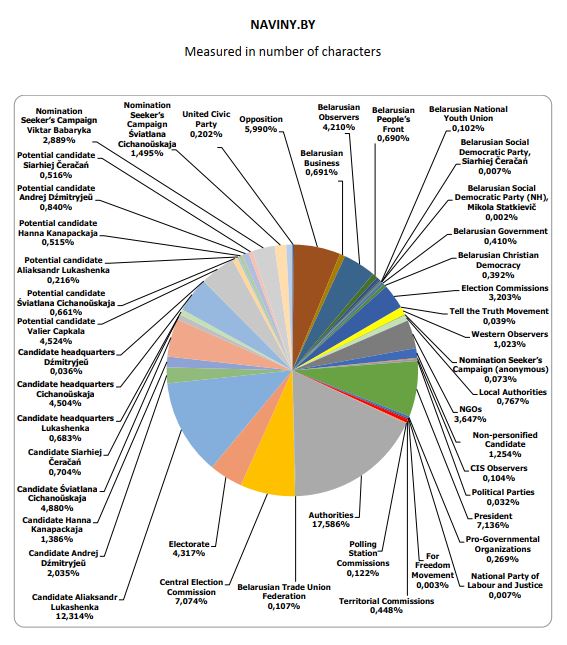
The Narodnaja Vola paper gave the opposition and its activities quite a lot of coverage, assessing them in a neutral and critical manner, and spoke about the CEC neutrally and critically. The paper presented the presidential hopefuls Mr Dźmitryjeŭ (6%) and Mr Čeračań (2%) neutrally, spoke negatively about Mrs Kanapackaja (about 2%), and covered Mrs Cichanoŭskaja in a neutral light, at the same time speaking positively about her campaign (the combined share was about 8%). The Narodnaja Vola spoke critically and neutrally about incumbent/presidential candidate Lukašenka, allocating to him about 6% of the space given to all the monitored actors.
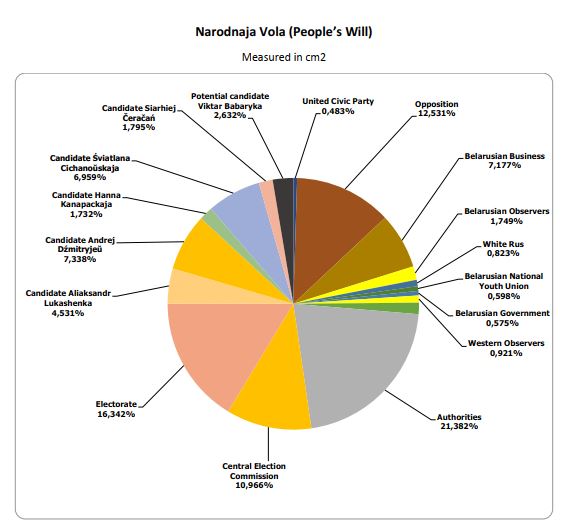
The Komsomolskaya Pravda v Belorussii wrote about each of the candidates, mostly giving them neutral coverage. Incumbent/presidential candidate Lukašenka received maximal attention (43% of the total space allocated to all the monitored actors). At the same time, the paper spoke critically about some of his statements. Mr Dźmitryjeŭ came second (8%). Mrs Kanapackaja, Mrs Cichanoŭskaja with her campaign and Mr Čeračań each received about 4% of the total space allocated to all the monitored actors.
4. Conclusions
The state-run media actively worked for the campaign of one candidate, President Lukašenka. Even though his contenders were granted an opportunity to address the electorate via TV and the radio live, they remained overshadowed by the coverage given to the incumbent.
These media were not a platform for airing critical opinions and discussions concerning the Belarusian reality and the country’s future. Moreover, they did not perceive the presidential race as a contest of ideas and visions of Belarus’ development and its prospects.
The assessments the state-run media gave to the country leader (who is at the same time a presidential candidate) and his work led to the conclusion that there is no alternative to the incumbent. The message was that if he was not re-elected, Belarus would face chaos, war, partition and a loss of independence.
As for the independent media they focused on providing information in their election coverage, clearly defined each candidate’s positions and treated them either neutrally or critically. They also presented opinions of different participants in the election process.
During all the preceding elections, both parliamentary and presidential, the state-run media had a decisive impact on the election process. However, this campaign has made it obvious that they have lost some of their influence. This is substantiated by the numbers of views and comments on Youtube media products owned by the state-run TV stations. We can speak of a new balance between trust and distrust that the upcoming election has revealed.
More illustrations and methodology — in the attached files:
Bulletin
Graphs
Methodology
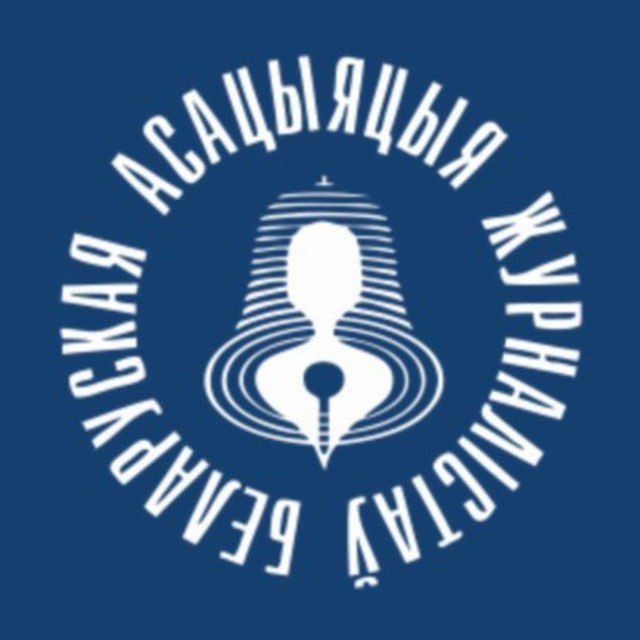 @bajmedia
@bajmedia
